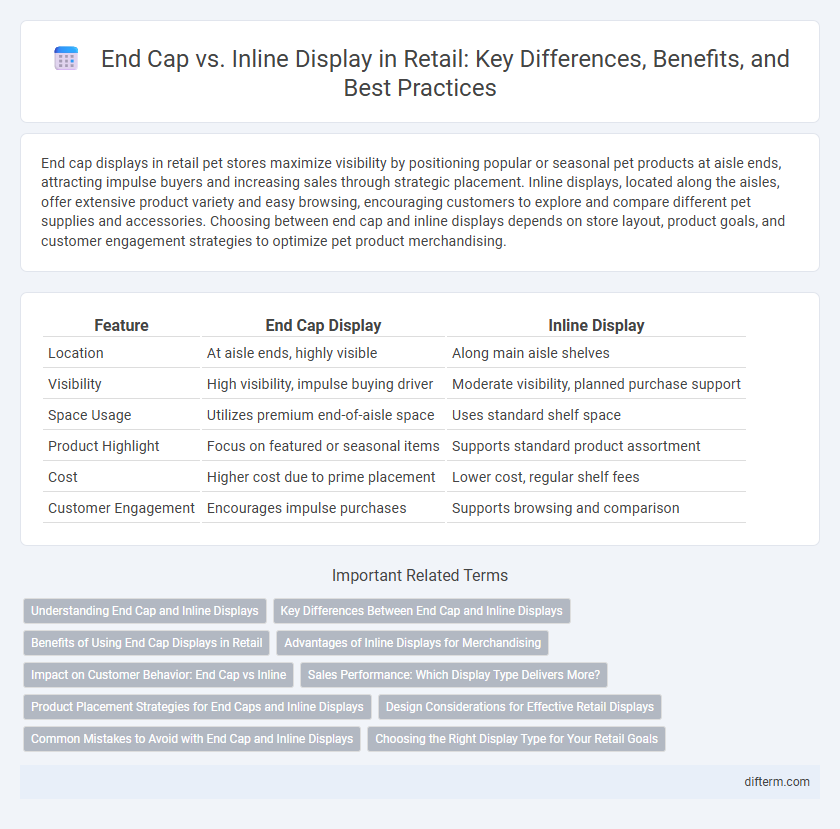End cap displays in retail pet stores maximize visibility by positioning popular or seasonal pet products at aisle ends, attracting impulse buyers and increasing sales through strategic placement. Inline displays, located along the aisles, offer extensive product variety and easy browsing, encouraging customers to explore and compare different pet supplies and accessories. Choosing between end cap and inline displays depends on store layout, product goals, and customer engagement strategies to optimize pet product merchandising.
Table of Comparison
| Feature | End Cap Display | Inline Display |
|---|---|---|
| Location | At aisle ends, highly visible | Along main aisle shelves |
| Visibility | High visibility, impulse buying driver | Moderate visibility, planned purchase support |
| Space Usage | Utilizes premium end-of-aisle space | Uses standard shelf space |
| Product Highlight | Focus on featured or seasonal items | Supports standard product assortment |
| Cost | Higher cost due to prime placement | Lower cost, regular shelf fees |
| Customer Engagement | Encourages impulse purchases | Supports browsing and comparison |
Understanding End Cap and Inline Displays
End cap displays are strategically placed at the end of aisles to attract maximum customer attention and increase impulse purchases, leveraging high-visibility positions to promote featured products effectively. Inline displays are located within the main aisle, providing continuous exposure and facilitating easy product comparison, which enhances customer shopping flow and product accessibility. Both display types serve critical roles in retail merchandising by optimizing product visibility and driving sales through targeted placement strategies.
Key Differences Between End Cap and Inline Displays
End cap displays are positioned at the end of store aisles, maximizing visibility and attracting impulse purchases by showcasing featured or seasonal products. Inline displays run along the sides of aisles between shelving units, providing continuous exposure to products within a category and encouraging thorough browsing. The key difference lies in location and impact: end caps drive higher attention and sales spikes, while inline displays support extensive product selection and brand reinforcement.
Benefits of Using End Cap Displays in Retail
End cap displays in retail maximize product visibility by positioning items at the end of aisles, capturing customer attention from multiple directions and increasing impulse purchases. These displays create high-impact promotional spaces that drive sales by highlighting seasonal or new products in a convenient and accessible location. Compared to inline displays, end caps offer enhanced foot traffic engagement and better inventory turnover due to their prominent placement.
Advantages of Inline Displays for Merchandising
Inline displays offer superior visibility by aligning products along the main shopping aisles, increasing customer engagement and boosting sales potential. Their flexibility in size and placement allows retailers to customize merchandising strategies to fit store layouts and seasonal promotions efficiently. These displays facilitate easier restocking and inventory management, enhancing operational efficiency and maintaining consistent product availability.
Impact on Customer Behavior: End Cap vs Inline
End cap displays significantly increase product visibility and impulse purchases by positioning items at the end of aisles, capturing customer attention as they navigate the store. Inline displays, located within aisles, promote deliberate product selection and comparison by guiding shoppers through organized categories. Studies show end caps can boost sales by up to 50% more than inline displays due to their higher foot traffic exposure and strategic placement.
Sales Performance: Which Display Type Delivers More?
End cap displays consistently outperform inline displays in sales performance by attracting 20-30% more shopper attention, leading to increased impulse purchases and higher conversion rates. Positioned at aisle ends, end caps benefit from greater visibility and foot traffic, making them ideal for promotions and new product launches. Inline displays, while effective for brand consistency along aisles, generally yield lower sales uplift due to limited exposure and shopper engagement.
Product Placement Strategies for End Caps and Inline Displays
End caps maximize visibility by positioning high-margin or promotional products at the end of aisles, capturing shopper attention and increasing impulse buys. Inline displays, located within aisles, enhance product accessibility and encourage comparison shopping among related items. Strategic placement of end caps drives sales velocity, while well-organized inline displays support shopper decision-making and category depth.
Design Considerations for Effective Retail Displays
End cap displays maximize visibility by utilizing high-traffic aisle intersections, making them ideal for promotional or seasonal products, while inline displays depend on consistent shelf space along the main aisle for steady product exposure. Effective design considerations include product assortment, eye-level placement, and traffic flow analysis to optimize shopper engagement and impulse purchases. Utilizing bold signage, strategic lighting, and clear messaging enhances the functionality of both end cap and inline displays within retail environments.
Common Mistakes to Avoid with End Cap and Inline Displays
Common mistakes to avoid with end cap and inline displays include overcrowding products, which diminishes visibility and reduces shopper engagement. Incorrect placement, such as positioning end caps too close to competing displays, can confuse customers and limit traffic flow. Failing to regularly update the displays leads to stale presentations that fail to capitalize on seasonal trends or promotions.
Choosing the Right Display Type for Your Retail Goals
Selecting the right display type depends on your retail objectives, product visibility, and customer traffic patterns. End cap displays attract high foot traffic and boost impulse buys by showcasing products at aisle intersections, while inline displays maximize shelf space and cater to consistent shopper flow along aisles. Evaluating your store layout and target audience behavior ensures optimal placement and enhances overall sales performance.
End Cap vs Inline Display Infographic

 difterm.com
difterm.com